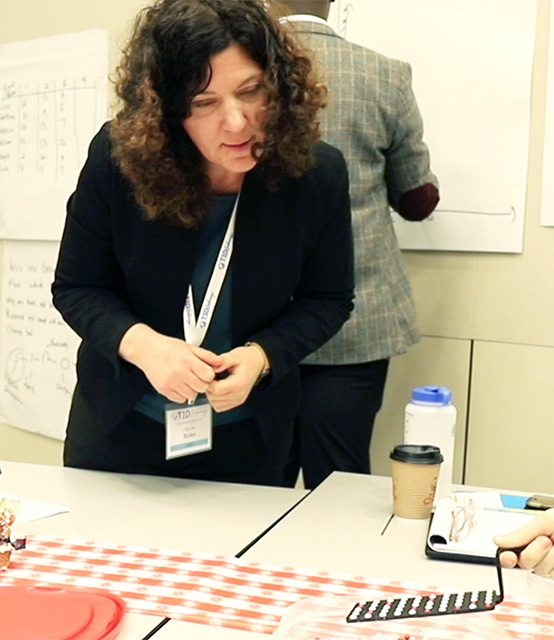
Sign up for a new account.
And get access to
The latest T1D content
Research that matters
Our daily questions
Sign up by entering your info below.
Reset Your Password
Don't worry.
We will email you instructions to reset your
password.
Providing supportive care for those living with T1D is complex and comes with an ongoing responsibility of knowing how to refine best practices and improve patient care.
But the process of identifying possible ideas for improvement, testing those ideas, analyzing the results, and then implementing a change in care is not an easy task. It’s also not something most clinics could pursue on their own.
These are the driving forces behind the T1D Exchange Quality Improvement Collaborative.
What is the T1D Exchange Quality Improvement Collaborative (T1DX-QI)?
The T1DX-QI is a network of 50+ endocrinology clinics across the US, collectively caring for over 80,000 people with T1D. These clinics work together to identify areas of unmet need and use data and implementation science to make changes in clinical practice.
Established in 2016, the Quality Improvement Collaborative (T1DX-QI) was created by the T1D Exchange in an ambitious effort to refine best practices, enhance the quality of care, and improve outcomes for people living with T1D across the United States.
 “We are proud of the T1DX-QI’s rapid growth to over 50 clinics, demonstrating that our data sharing and collaborative improvement approaches are adding real value across the T1D landscape,” said Osagie Ebekozien, Vice President of Population Health and Quality Improvement at T1D Exchange. “By working together with leading U.S. diabetes clinics, we are testing and implementing real-world solutions with benefits that can be scaled to the diabetes community.”
“We are proud of the T1DX-QI’s rapid growth to over 50 clinics, demonstrating that our data sharing and collaborative improvement approaches are adding real value across the T1D landscape,” said Osagie Ebekozien, Vice President of Population Health and Quality Improvement at T1D Exchange. “By working together with leading U.S. diabetes clinics, we are testing and implementing real-world solutions with benefits that can be scaled to the diabetes community.”
The T1DX-QI has achieved success because it relies on an embedded and systemic approach: individual providers are empowered to identify areas of unmet need within their respective clinics. They make targeted changes in care that scale up through the T1DX-QI to create best practices, shared and implemented by members at other clinics.
“We are a learning health collaborative,” explains Nicole Rioles, the T1DX-QI’s Associate Director. “We use tests of change and quality improvement to improve processes, workflows, patient education, healthcare practitioner education, screening, and treatment.”
“The T1DX-QI means clinics can learn together,” says Rioles. “One clinic can share what they’ve learned, and another clinic with a similar infrastructure can take that entire lesson and apply it to their own patient care. They don’t have to start from scratch.”
The results of the T1DX-QI essentially come down to sharing the key ingredients for the best recipes in T1D patient care.
The T1DX-QI Portal: How Does It Work?
One of the most powerful tools within the T1DX-QI is the portal system. The T1DX-QI Portal is a comprehensive and secure program designed to enable each clinic to submit data on their own patient population and then review and compare their data against the clinical averages of every other participating clinic.
Every new clinic in the T1DX-QI receives tutorials and support in understanding how to manage and make the most of their own portal data.
With secure login credentials, the T1DX-QI Portal dashboard offers tremendous yet easily sortable data across nearly every aspect of managing T1D.
- Compare your clinic’s data to other clinical averages to assess overall patient care.
- Use data to determine if your clinic is below or above average in T1D care metrics.
- Use data to pinpoint specific areas of focus most in need of attention.
- Sort data by population characteristics including age, ethnicity, years since diagnosis, location, and clinic size.
A few of the dashboard’s care-focused selectable metrics include:
- median HbA1c
- HbA1c’s over/under certain percentage
- CGM use
- pump use
- DKA admissions
- patients screened/not screened for depression
Clinics can then select different metrics within their portal to focus their efforts on for improvement.
“It can be quite a reality check,” adds Rioles. “It helps a clinic better understand who their population of need is and what they should be prioritizing in care processes.”
The portal also enables a clinic to see, for example, who hasn’t been screened for depression. A clinic can then make it a priority to screen that group of patients at their next appointment for depression, ensuring no patient in need of support slips through the cracks.
*The T1D Exchange or participants involved in the T1DX-QI never receive any patient-identifying data. For any clinic to gain patient-specific information, the [hospital] IT team decodes the data so it can be put to use in the clinical setting.
How the T1DX-QI Turns Data Into Real Improvements in T1D Care
At the heart of the T1DX-QI is the value of data benchmarking and the resulting “change packages.”
- Benchmarking: Benchmarking is a critical and valuable aspect of the T1DX-QI. Each clinic that joins the T1DX-QI is eventually able to actively contribute and benefit from benchmarking by comparing their clinic’s data to data from other clinics. By logging in to the T1DX-QI Portal, each participating clinic can easily evaluate its own data against another’s to assess where they’re thriving and where its next efforts should be focused.
- Change Packages: Change packages are the culmination of many clinics testing one hypothesis, running and completing a study, analyzing the results, and coming to an effective conclusion, then packaging the process efficiently so the successful change can be shared and applied in other endocrine clinics. They are essentially recipes for success.
“We collect data together, we set goals, create measures, and benchmark our work which helps us build an entire body of data,” adds Rioles. “Analyzing this data and understanding the trends is how we determine what improvements can make a difference.”

By using the T1DX-QI portal to review specific metrics and compare that data to other clinics, it allows a clinic to see very quickly where they could make remarkable improvements in patient care.
For example, merely 3 or 4 years ago, most diabetes clinics did not screen for depression in people with T1D.
“There was no benchmark,” explains Rioles. “We didn’t know if there were a lot of patients struggling with depression or if there were none. To gain a foundational understanding of this, clinics need to commit to routinely screen patients for depression.”
Through the T1DX-QI, this data collection has led to new and significant understandings of the prevalence of depression in this patient population which means greater intervention and treatment for these patients, too.
By sharing this data from clinic to clinic, more clinics can begin screening their own patients which means a greater percentage of people with T1D across the country will receive that intervention and support through change packages.
Improving Outcomes & Care for People with T1D
Here’s a glance at some of the impactful research from the T1DX-QI, accomplished through the T1DX-QI’s mission to work together in the effort to improve outcomes and care of people with T1D:
- COVID-19 Hospitalization in Adults with T1D: Risk & Outcomes
In a year filled with unknowns, the T1D Exchange Quality Improvement Collaborative launched a study on April 6th to provide some answers. This study found that patients with T1D and COVID-19 were more likely to be hospitalized if they were older, identified as non-Hispanic Black, had public insurance, had a higher HbA1c, or had hypertension. - A Practical Framework to Integrate Health Equity
The T1DX-QI developed a 10-step framework to guide healthcare providers in their efforts to improve the health of everyone with T1D. This framework is a tool that can be used to help pave the way for a more equitable healthcare system. - Improving Continuous Glucose Monitor (CGM) Use
Ten diabetes centers in the T1DX-QI successfully proved that we can improve CGM use by assessing and removing barriers to adoption, developing CGM patient education classes, and advocating for state Medicaid coverage. By understanding the best methods to increase CGM usage, we are one step closer to improving outcomes for all people living with T1D. - Increasing the Use of Insulin Pumps
The benefits of insulin pumps compared to multiple daily injections have been demonstrated through multiple studies. Five clinics in the T1DX-QI established cycles to test and expand insulin pump use in patients aged 12 to 26 years old. Three of the five participating centers had substantial improvement in this process, ranging from 6% to 17%. There was a 10% significant change among the collaborative cohort in 20 months. Successful QI interventions improved pump use. - Reducing the Proportion of Patients with HbA1c Levels Over 9%
10 T1DX-QI clinics worked collaboratively on the goal of reducing HbA1c levels in high-risk patients — defined as patients with HbA1c’s over 9.0 percent. Successful efforts include: utilizing a patient navigator, workflow redesign, developing insulin pump and CGM education classes, depression screening, and addressing social determinants of health. The Collaborative set a goal to decrease the percentage of high-risk patients by 5% from baseline and made a significant 3% improvement. Continued efforts are needed to expand interventions to additional sites to reduce the number of high-risk patients. - Investigating Factors that Worsen Diabetes Care
The difference in healthcare provided to certain populations of people with type 1 diabetes (T1D) has become impossible to ignore. Race, ethnicity, and type of insurance are some of the most obvious contributing factors. Identifying these health inequities led to the Health Equity Advancement Lab (HEAL) creation in April 2021. The first goal of the HEAL program was to identify the factors that negatively impact the healthcare provided to certain racial and ethnic groups with T1D. - How a Person’s Race & Ethnicity Affect Their T1D Care
The ongoing COVID-19 pandemic shone a bright light on the drastic differences in the healthcare provided to people with and without diabetes. In diabetes, health inequity proves to be a dangerously pervasive problem in both pediatric and adult settings across the United States. Despite so many advancements in diabetes technology and medications over the past 30 years, the care a person receives can still vary dramatically based on their race and ethnicity.
Ginger Vieira
Related Stories
9 Comments
Breaking Down the Science: All About The T1D Exchange Quality Improvement Collaborative Cancel reply
You must be logged in to post a comment.








Improving processes step by step takes careful planning and reliable information. Similarly, Drinks menu it is an updated guide to Starbucks menu categories—coffees, teas, refreshers, nutrition details, and a handy calculator—helps you systematically explore and understand every option before making a choice. Having a clear reference like this makes decision-making much more efficient and effective.
The focus on quality improvement and data-driven insights here is impressive. It reminds me how tools like a Beste Rekenmachine simplify complicated information into something actionable.